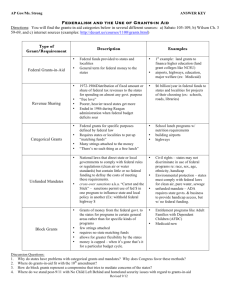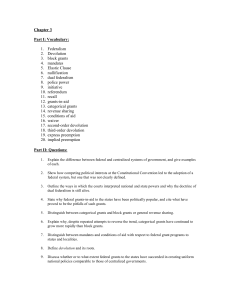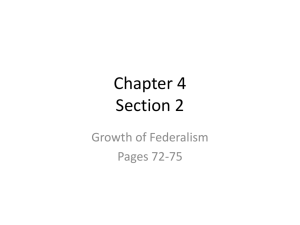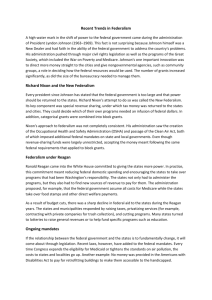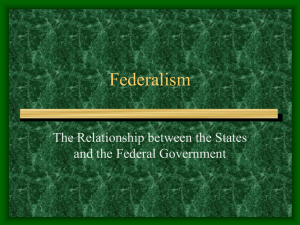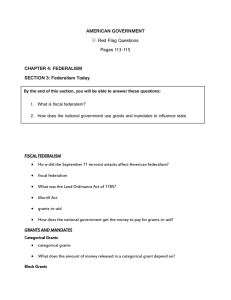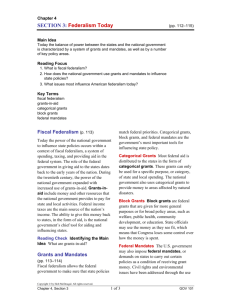TOPIC #8 -- FEDERALISM -- AID, PREEMPTION, MANDATES & RESTRAINT
advertisement
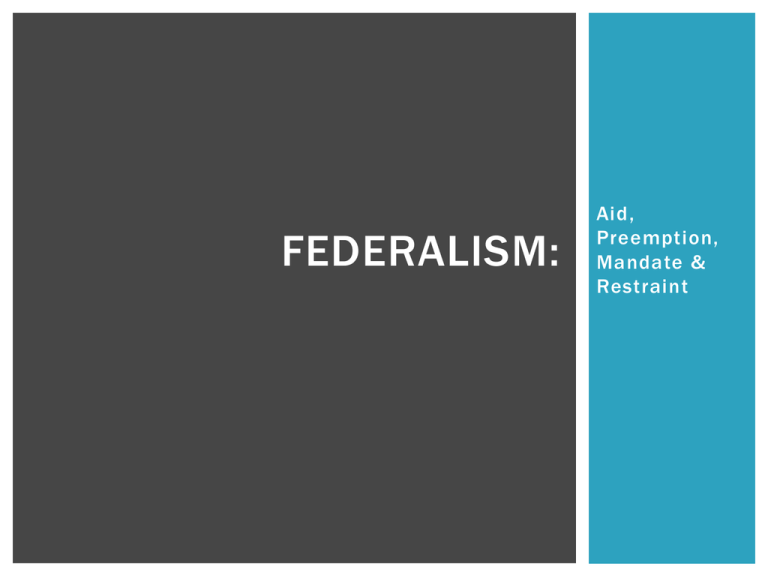
FEDERALISM: Aid, Preemption, Mandate & Restraint GRANTS-IN-AID Money paid by one level of government to another level of government to be spent for a given purpose T YPES OF GRANTS Categorical grants are those grants targeted for a specific purpose by either formula or project Formula grants are distributed according to a particular set of rules; who is eligible and how much will they receive Project grants are awarded on the basis of competitive applications to perform a specific task or function Example: Smaller Learning Communities Block grants are awarded for general purposes allowing the recipient great discretion in spending the grant money GRANTS-IN-AID Redistributed tax dollars to the state and local governments Formulas used to distribute grants can be highly political All grant money has strings attached Strings can ensure the money is spent for the designated purpose; determine the effectiveness of the grant; achieve some broad national goal not always attached to the purpose of the grant GRANTS-IN-AID: DRINKING AGE If states did not raise their drinking age to 21, Congress threatened to reduce their highway funding South Dakota v. Dole (1987) Court ruled that Congress could not mandate a national drinking age, but they could offer an incentive for states to adopt a higher drinking age CONDITIONS OF AID Attached to federal grant money given to the states If states don’t want the strings, they can opt to not take federal money PROBLEM. . . Conditions can be specific i.e. environmental impact statements CONDITIONS OF AID Federal government believes it is obligated to develop uniform national policies and to ensure the states do not misspend federal funds States feel certain conditions do not take local conditions and costs into account. Did someone say free money?? PREEMPTION Power of Congress to enact laws by which the national government assumes total or partial responsibility for a state function Example: Nutrition Labeling & Education Act (1990) – established national standards for food labels, stripping the states of their power to impose food label requirements Prevents states from requiring added information to labels MANDATES Federal rules states or localities must obey Funding is not necessarily linked Example: civil rights Mandates can be vague allowing federal agencies to decide what states and localities are supposed to do Example: Americans with Disabilities Act was enacted with no clear cut explanation of what “equal access” means, how the law was to be administered or how much it would cost the states MANDATES Can also be either be inadequately funded by the federal government or completely unfunded Example – No Child Left Behind Unfunded Mandates Relief Act (1995) – requires the Congressional Budget Office to prepare cost estimates of any new legislation that would impose more than $50 million/year on state and local governments or more than $100 million/year in costs on private businesses RESTRIANT Forbids state governments from exercising a certain power Example – Bus Regulatory Reform Act (1982) Forbade the states from imposing conditions that would restrict bus service to out-of-the-way areas AS A RESULT . . . Due to the many conditions attached to federal aid, some states have found ways to improvise Turn over trash collection to private firms Encourage welfare recipients to take get jobs This led to a devolution of federal power to the states by the 1990’s
